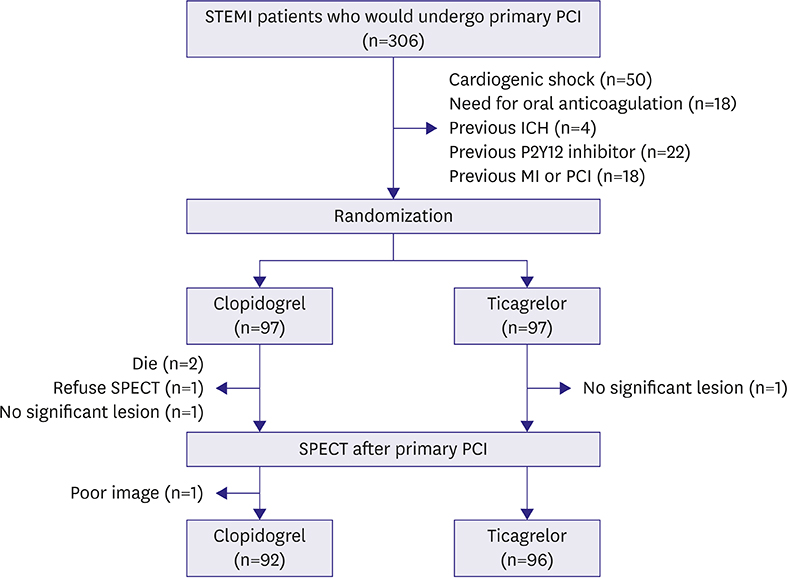Korean Circ J.
2017 Sep;47(5):705-713. 10.4070/kcj.2017.0044.
Comparison of the Infarct Size between the Loading of Ticagrelor and Clopidogrel in Patients with Acute Myocardial Infarction Undergoing Primary Percutaneous Coronary Intervention
- Affiliations
-
- 1Department of Cardiovascular Medicine, Regional Cardiocerebrovascular Center, Wonkwang University Hospital, Iksan, Korea. bsjsh@chol.com
- KMID: 2389603
- DOI: http://doi.org/10.4070/kcj.2017.0044
Abstract
- BACKGROUND AND OBJECTIVES
Ticagrelor is considered a potent antiplatelet agent compared to clopidogrel. However, there are no studies regarding the effect of ticagrelor loading on infarct size in patients with ST-segment elevation myocardial infarction (STEMI) in a primary percutaneous coronary intervention (PCI) setting.
SUBJECTS AND METHODS
In this single-center, randomized, open-label study, 188 patients who underwent primary PCI for STEMI were enrolled (92 patients in the clopidogrel group and 96 in the ticagrelor group) and compared the infarct size by technetium-99m (Tc-99m) tetrofosmin single-photon emission computed tomography (SPECT) and serial cardiac biomarker levels between the groups. SPECT was performed at a median of 2 days after PCI.
RESULTS
Baseline clinical and procedural characteristics were similar between the groups. Infarct size on SPECT, was similar between the 2 groups (28.1%±34.5% vs. 32.8%±29.2%; p=0.169). At all time-points after PCI (8, 24, and 48 hours), the peak levels of creatine kinase-myocardial band (CK-MB) and troponin T were lower in the clopidogrel group. The clopidogrel group showed lower cumulative troponin T levels than the ticagrelor group (12.59±10.66 vs. 17.67±19.51 ng/mL; p=0.029).
CONCLUSION
Ticagrelor loading before primary PCI was not associated with reduced myocardial infarct size during the first 48 hours, compared to clopidogrel loading.
MeSH Terms
Figure
Reference
-
1. Wallentin L, Becker RC, Budaj A, et al. Ticagrelor versus clopidogrel in patients with acute coronary syndromes. N Engl J Med. 2009; 361:1045–1057.2. Bonello L, Laine M, Kipson N, et al. Ticagrelor increases adenosine plasma concentration in patients with an acute coronary syndrome. J Am Coll Cardiol. 2014; 63:872–877.3. Nanhwan MK, Ling S, Kodakandla M, Nylander S, Ye Y, Birnbaum Y. Chronic treatment with ticagrelor limits myocardial infarct size: an adenosine and cyclooxygenase-2-dependent effect. Arterioscler Thromb Vasc Biol. 2014; 34:2078–2085.4. Vilahur G, Gutiérrez M, Casani L, et al. Protective effects of ticagrelor on myocardial injury after infarction. Circulation. 2016; 134:1708–1719.5. van’t Hof AW, Liem A, Suryapranata H, et al. Angiographic assessment of myocardial reperfusion in patients treated with primary angioplasty for acute myocardial infarction: myocardial blush grade. Zwolle Myocardial Infarction Study Group. Circulation. 1998; 97:2302–2306.6. Gibson CM, Cannon CP, Daley WL, et al. TIMI frame count: a quantitative method of assessing coronary artery flow. Circulation. 1996; 93:879–888.7. Kim JW, Yun KH, Kim EK, et al. Effect of high dose rosuvastatin loading before primary percutaneous coronary intervention on infarct size in patients with ST-segment elevation myocardial infarction. Korean Circ J. 2014; 44:76–81.8. Hahn JY, Kim HJ, Choi YJ, et al. Effects of atorvastatin pretreatment on infarct size in patients with ST-segment elevation myocardial infarction undergoing primary percutaneous coronary intervention. Am Heart J. 2011; 162:1026–1033.9. Alexopoulos D, Moulias A, Koutsogiannis N, et al. Differential effect of ticagrelor versus prasugrel on coronary blood flow velocity in patients with non-ST-elevation acute coronary syndrome undergoing percutaneous coronary intervention: an exploratory study. Circ Cardiovasc Interv. 2013; 6:277–283.10. Wittfeldt A, Emanuelsson H, Brandrup-Wognsen G, et al. Ticagrelor enhances adenosine-induced coronary vasodilatory responses in humans. J Am Coll Cardiol. 2013; 61:723–727.11. Lee CW, Hwang I, Park CS, et al. Comparison of differential expression of P2Y12 receptor in culprit coronary plaques in patients with acute myocardial infarction versus stable angina pectoris. Am J Cardiol. 2011; 108:799–803.12. Park SD, Lee MJ, Baek YS, et al. Randomised trial to compare a protective effect of Clopidogrel Versus TIcagrelor on coronary Microvascular injury in ST-segment Elevation myocardial infarction (CV-TIME trial). EuroIntervention. 2016; 12:e964–e971.13. Gibbons RJ. Tc-99m SPECT sestamibi for the measurement of infarct size. J Cardiovasc Pharmacol Ther. 2011; 16:321–331.14. Lund GK, Stork A, Saeed M, et al. Acute myocardial infarction: evaluation with first-pass enhancement and delayed enhancement MR imaging compared with 201Tl SPECT imaging. Radiology. 2004; 232:49–57.15. Hadamitzky M, Langhans B, Hausleiter J, et al. Prognostic value of late gadolinium enhancement in cardiovascular magnetic resonance imaging after acute ST-elevation myocardial infarction in comparison with single-photon emission tomography using Tc99m-Sestamibi. Eur Heart J Cardiovasc Imaging. 2014; 15:216–225.16. Pellikka PA, Behrenbeck T, Verani MS, Mahmarian JJ, Wackers FJ, Gibbons RJ. Serial changes in myocardial perfusion using tomographic technetium-99m-hexakis-2-methoxy-2-methylpropyl-isonitrile imaging following reperfusion therapy of myocardial infarction. J Nucl Med. 1990; 31:1269–1275.
- Full Text Links
- Actions
-
Cited
- CITED
-
- Close
- Share
- Similar articles
-
- Risk of Bleeding and Ischemia in Elderly East Asian Patients with Diabetes Mellitus Treated with either Clopidogrel or Ticagrelor: From the Korean Acute Myocardial Infarction Registry-V
- Hypersensitivity to ticagrelor and low response to clopidogrel: a case report
- Clinical Outcomes of Ticagrelor in Korean Patients with Acute Myocardial Infarction without High Bleeding Risk
- Temporal Variability of Platelet Reactivity in Patients Treated with Clopidogrel or Ticagrelor
- Current Status of Coronary Intervention in Patients with ST-Segment Elevation Myocardial Infarction and Multivessel Coronary Artery Disease



